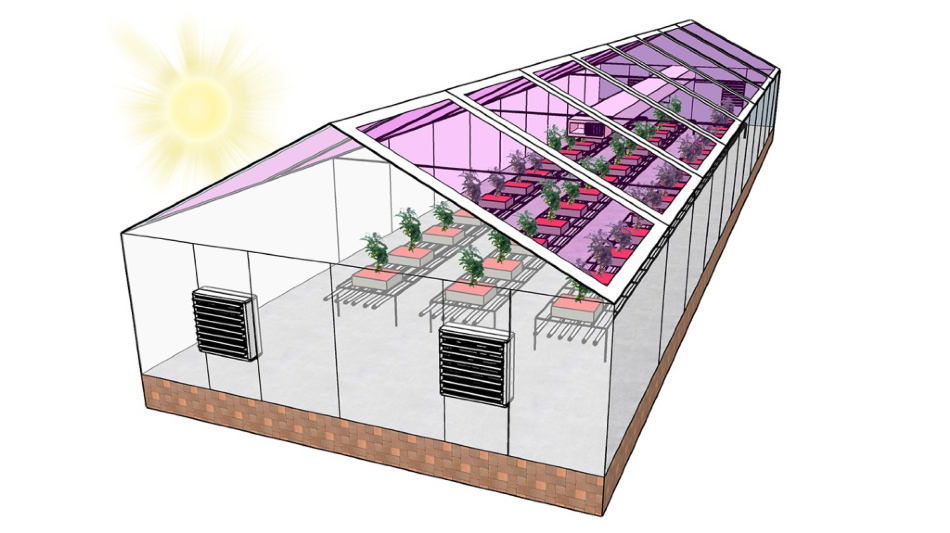Feb 10 2020
A majority of the greenhouses can be made energy neutral by utilizing transparent solar panels to harvest solar energy, mainly from the wavelengths of light that are not used by plants for photosynthesis.
 Many greenhouses could become energy neutral by using see-through solar panels to harvest energy—primarily from the wavelengths of light that plants don’t use for photosynthesis. In some places, this could make greenhouses energy neutral, or even allow them to generate enough electricity to sell it back to the grid—creating a new revenue stream for growers. Image Credit: Brendan O’Connor, NC State University.
Many greenhouses could become energy neutral by using see-through solar panels to harvest energy—primarily from the wavelengths of light that plants don’t use for photosynthesis. In some places, this could make greenhouses energy neutral, or even allow them to generate enough electricity to sell it back to the grid—creating a new revenue stream for growers. Image Credit: Brendan O’Connor, NC State University.
These were the findings of the latest modeling study carried out by physics, engineering, and plant biology scientists at North Carolina State University (NC State).
Plants only use some wavelengths of light for photosynthesis, and the idea is to create greenhouses that make energy from that unused light while allowing most of the photosynthetic band of light to pass through.
Brendan O’Connor, Associate Professor, Department of Mechanical and Aerospace Engineering, North Carolina State University
O’Connor continued, “We’re able to do this by using organic solar cells, because they allow us to tune the spectrum of light that the solar cell absorbs—so we can focus on using mostly wavelengths of light that plants don’t use. However, until now it wasn’t clear how much energy a greenhouse could capture if it was using these semitransparent, wavelength selective, organic solar cells.”
O’Connor is also the study’s corresponding author.
Scientists utilized a computational model to deal with that question. They used this method to predict the amount of energy that might be produced by a greenhouse if its roof was installed with semi-transparent organic solar cells, and whether that energy would be sufficient to compensate the amount of energy needed for the greenhouse to work effectively.
The computational model was developed to predict the amount of energy used in greenhouses to grow tomatoes at places such as Wisconsin, North Carolina, and Arizona.
A lot of the energy use in greenhouses comes from heating and cooling, so our model focused on calculating the energy load needed to maintain the optimal temperature range for tomato growth. The model also calculated the amount of energy a greenhouse would produce at each location when solar cells were placed on its roof.
Brendan O’Connor, Associate Professor, Department of Mechanical and Aerospace Engineering, North Carolina State University
However, the modeling is rather complex because there is an intricate trade-off between the amount of light present in the photosynthetic band that they enable to pass through and the amount of power generated by the solar cells. At the fundamental level, growers can generate more power if they are ready to sacrifice bigger amounts of photosynthetic growth.
Moreover, the solar cells utilized in this study are effective insulators because they are capable of reflecting infrared light. This approach traps more amount of warmth during the winter period and helps keeps the greenhouses cooler during the summer period.
The ultimate outcome is that there may not be a huge trade-off for a majority of the greenhouse operators, specifically for greenhouses located in temperate or warm climates.
For instance, the greenhouses in Arizona may become energy neutral, without the need for any external power source while blocking just 10% of the photosynthetic band of light. But if growers are prepared to block more amounts of photosynthetic light, they are likely to produce double the energy needed by them to operate their greenhouses.
A greenhouse in North Carolina may turn out to be energy neutral while blocking 20% of the photosynthetic band of light. On the other hand, greenhouses in Wisconsin could not become energy neutral even if the same semi-transparent solar cells are used because too much energy is required to keep the greenhouse warm in winter.
But it has been estimated that the solar cells can meet up to 46% of the energy demand of the greenhouse.
While the technology does use some of the light plants rely on, we think the impact will be negligible on plant growth—and that the trade-off will make financial sense to growers.
Brendan O’Connor, Associate Professor, Department of Mechanical and Aerospace Engineering, North Carolina State University
The study, titled “Achieving Net Zero Energy Greenhouses by Integrating Semitransparent Organic Solar Cells,” was published in the Joule journal.
The study’s first author is Eshwar Ravishankar, a PhD student at NC State. The paper was co-authored by Ronald Booth, a PhD student at NC State; Carole Saravitz, director of the NC State University Phytotron; Heike Sederoff, professor of plant and microbial biology at NC State; and Harald Ade, Goodnight Innovation Distinguished Professor of Physics at NC State.
The study was funded by the National Science Foundation, under grant number 1639429.